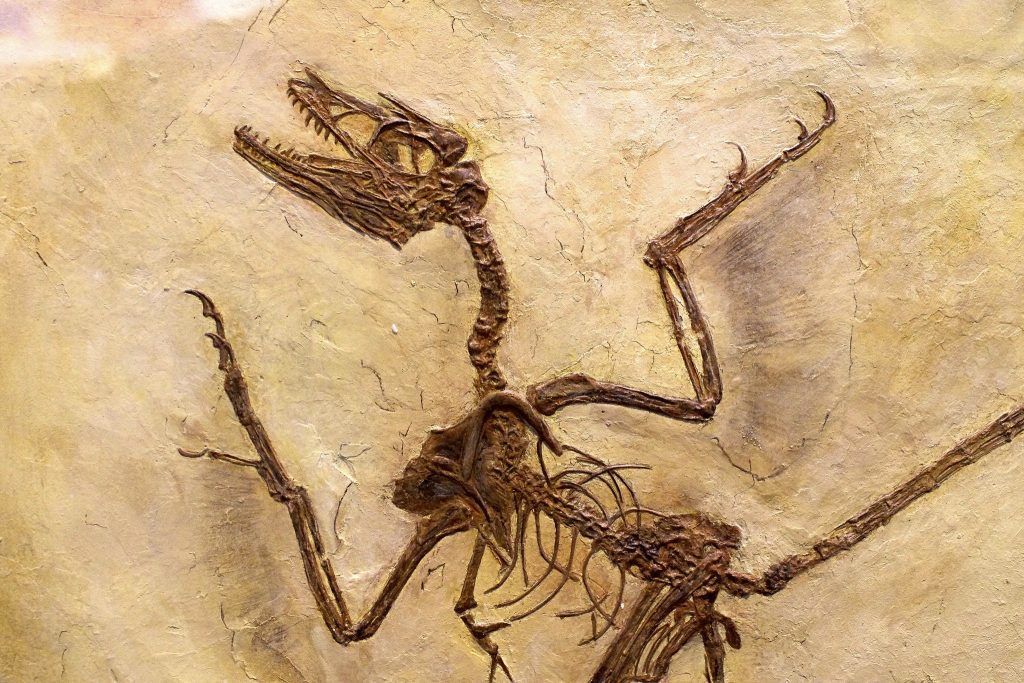It’s no secret dinosaurs possessed their own fair share of dirty habits—most bodies can get pretty gross, no matter the species. But dandruff? Nobody really saw that coming.
A new study published in Nature Communications illustrates the discovery of some 125 million-year-old dinosaur dandruff fossils. The findings aren’t just a quick excuse for making a bad Head and Shoulders quip, but also actually explain a mechanism by which dinosaurs did something nearly universal: shed skin.
“Probably nobody much thought about how dinosaurs shed their skin before,” says Mike Benton, a professor of vertebrate paleontology at the University of Bristol and a coauthor of the new study. The new findings “tell us that dinosaurs were like birds, shedding their skin in small flakes.”
The findings stem from the analysis of feathers from the Cretaceous period in China, from three different dinosaur species (Microraptor, Beipiaosaurus, and Sinornithosaurus) and the early bird Confuciusornis. Benton and his colleagues had been working with the specimens since 2007, and the characterization of the skin flakes is just their latest milestone.
All animals molt, or rid themselves of old skin and feathers and hair, so they can grow larger and new face environmental challenges with a fresh new coat of exterior tissue. Before the new findings, there was a dearth in understanding how dinosaur skin worked and how the mighty beasts managed to shed it. The most prevalent theory was that molting in dinosaurs occurred in pieces, as it does in their closest modern relatives (birds and crocodiles). The whole-sheath skin shedding technique used by snakes and some lizards would have made less sense for dinosaurs, given that these species are more distantly related.
But during the group’s work using regular and electron microscopes, the researchers kept coming across strange white blobs located all over the plumage. Upon further investigation using ion beam microscope (which revealed the internal structure of the flakes), the team identified the specks as corneocytes: tough cells composed of twisted fibers of keratin, found in both modern birds as well as human dandruff.
“We avoided the word dandruff in the scientific paper since it’s a term usually applied to skin flakes between the hair of humans,” says Benton. “But this is what we’re seeing, trapped between shafts of feathers in the fossil birds and dinosaurs. They are tiny flakes of surface skin, measuring 1 to 2 millimeters across.” The team believes dandruff probably evolved during the Middle Jurassic period, during which there was a bloom in new feathery dinosaur species.
Beyond the fact that apparently dinosaurs would be embarrassed to wear black clothing without a good head scrub, the detail of the skin structure from the fossil shows us the species studied “were warm-blooded, but not as greatly as modern birds,” says Benton. Flying can produce enormous amounts of metabolic heat, and modern day birds use skin shedding as way facilitate evaporative cooling. The dinos, in contrast, possess more tightly packed corneocytes that are not as freely shed, so cooling through this mechanism would have been more limited. This suggests these dinosaurs probably generated lower amounts of heat during flight, if they could fly at all.
Danny Barta, a comparative biology researcher at the American Museum of Natural History who was not involved with the study, calls the findings “groundbreaking, particularly because we’ve never had such clear insight into the skin of feathered dinosaurs before.”
“The study confirms yet another shared feature between non-avian dinosaurs and birds, and it’s particularly exciting to see these similarities emerge in most regions of the anatomy, all the way down to the microstructural level,” Barta says.
Moving forward, Benton and his team want to extend their study of feathers and skin to other dinosaur specimens and see how common these features are, especially in species that are more closely related to modern birds. But personally, I’m hoping this paper is just the first in a new field of study focused on bad dinosaur hygiene—and that the results make it into the third “Jurassic World” movie. Don’t pretend you wouldn’t pay to see Chris Pratt and Bryce Dallas Howard battle against T. rex BO for 120 minutes.









